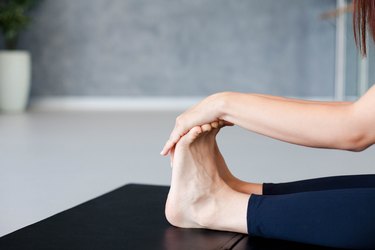
The next time you retire an old pair of running shoes, take a good look at the way the soles are wearing down. If they're worn down unevenly, especially around the inside of your foot, you could probably benefit from doing overpronation exercises to reset your gait.
Those worn spots on the inner part of the sole indicate that you aren't distributing your weight evenly when your foot lands on the ground. If your shoe is worn down on the outside of the sole, it means you have the opposite problem, underpronation, also known as supination.
Video of the Day
Video of the Day
What Is Overpronation?
You might be wondering why you should be concerned about the way you're distributing your weight across your foot when walking or running. As the American Academy of Orthopaedic Surgeons explains, overpronation and underpronation make you more susceptible to injuries.
Normal pronation involves landing on the heel, then transferring your weight from heel to the long bones of the foot, which are known as the metatarsals. Your weight transfers from the outside of the foot to the inside before you push off again with your big toe. Neutral pronation — the ideal kind to have — involves an even distribution of your weight across the foot.
Problems occur when people have high or low arches in their feet, according to UConn Health. If you have a low arch, your foot will roll excessively inward, putting too much weight on the big toe and potentially rolling the ankle inward. People with high arches, on the other hand, will roll inward only slightly, putting more weight on the outside of their foot.
Want to get a better idea of whether you overpronate or underpronate? Examining the bottom of your shoes for how the sole is wearing down will give you a pretty good idea, but you can also get a gait analysis from an orthopedist.
Try These Overpronation Exercises
If you have normal arches and pronate normally, be thankful. However, if you have a tendency to overpronate, don't think that you should be investing in special shoes or expensive arch supports. As the American College of Sports Medicine states, stopping pronation with padded shoes might actually hurt you, and you should instead aim to correct excessive pronation with exercises that strengthen the foot.
A physical therapist or orthopedist is the best person to recommend the overpronation exercises that are right for you, but there are a few you can start with on your own, says the American Council on Exercise. Strengthening the arches in your foot will provide a stronger foundation for your ankle and the rest of your body, thereby decreasing your risk of injury. Try one of these pronation exercises for stronger arches:
Move 1: Tripod Push
- Imagine your foot having three points: the big toe, the little toe and the heel. Stand and press those three points into the ground.
- Now try to squeeze your big toe, little toe and heel together, forcing your arch to contract. Hold for five to 10 seconds.
- Release.
- Repeat for five to 10 repetitions per session.
Move 2: Towel Pull
- With bare feet, sit on a chair with a towel spread out on the floor in front of you.
- Use your toes to pull the towel in toward your body, wrinkling it up as you go. This will force your arches to bend and curve as you pull the towel.
- Repeat for five to 10 repetitions per session.
Although these pronation exercises will strengthen your arch and reduce your risk of injury, they are not foolproof. Talk to a physical therapist or orthopedist about other steps you can take and other ways to improve your gait.
Is this an emergency? If you are experiencing serious medical symptoms, please see the National Library of Medicine’s list of signs you need emergency medical attention or call 911.